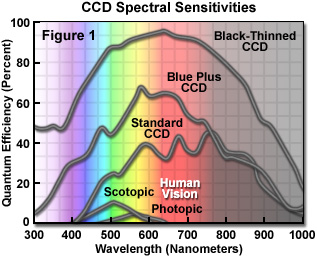![]()
This parameter is very important for a CCD sensor, as it expresses his efficiency, the capacity to capture the photons which strike him and use them to produce the outgoing signal, to the various wavelengths . It is expressed in percent at a certain wavelength . For example a value of 40% means that for 100 photons which strike the sensor 40 are really captured and changed in electrons.
The used manufacture techniques considerably affect the spectrum response of the sensor. As we can see from the image, the various models in fact present different responses.
Going back to the example of the glasses, it is as there were drops of various dimensions.The littlest ones represent the wavelengths which tend to the blue, while the biggest ones tend to the red. Not all of the drops are received in the same way: the little ones can dissolve before reaching the bottom of the glass, the big ones can not be taken by the glass.
Technically speaking, the CCD loses his sensitivity in the right extreme of the spectrum (infrared), because the photons have not enough energy to produce electrons inside the cells. From the other side (ultraviolet) the photons are not able to penetrate into the CCD quite deeply to enter into the cells and they are stopped by the superficial layers.Between these two extremes, interference effects can cause various peak and subsidence values in the response.
In general, major it is the Qe value, better is the device . Since the quantum efficiency will be high only for certain values in any case, it is important choose the sensor most suitable for its shooting demands . We need to point out that values that could seem low, as 10-20% are not at all to be snobbed, if one considers that 5% is seldom reached with the normal films!
![]()
Questo parametro e' molto importante per un sensore CCD, in quanto esprime la sua efficienza, cioe' la capacità di catturare i fotoni che lo colpiscono ed utilizzarli per generare l’uscita, alle diverse lunghezze d’onda. E' espresso in percentuale ad una certa lunghezza d’onda. Per esempio, un valore del 40% indica che su 100 fotoni che colpiscono il sensore 40 sono effettivamente catturati e trasformati in elettroni.
Le tecniche di fabbricazione utilizzate influenzano notevolmente la risposta spettrale del sensore. Come si vede dall’immagine i vari modelli presentano infatti risposte differenti.
Tornando all’esempio dei bicchieri, e' come se ci fossero gocce di diverse dimensioni. Le piu' piccole rappresentano le lunghezze d’onda tendenti al blu, mentre le piu' grandi quelle tendenti al rosso. Non tutte le gocce sono ricevute nella stessa maniera: le piccole possono dissolversi prima di raggiungere il fondo del bicchiere, le grandi possono non essere raccolte dal bicchiere.
Tecnicamente parlando, all’estremo destro dello spettro (infrarosso) il CCD perde la sua sensibilità perché i fotoni non hanno abbastanza energia per generare elettroni all’interno delle celle. Dall’altra parte (ultravioletto) i fotoni non riescono a penetrare abbastanza profondamente nel CCD per entrare nelle celle e vengono arrestati dagli strati superficiali. Tra questi due estremi, effetti di interferenza possono causare diversi picchi e avvallamenti nella risposta.
In generale, maggiore e' il valore di Qe, migliore e' il dispositivo. Dato che in ogni caso l’efficienza quantica potrà essere alta solo per certi valori, e' importante scegliere il sensore piu' adatto alle proprie esigenze di ripresa. Va sottolineato che valori che potrebbero sembrare bassi, come 10-20% non sono affatto da snobbare, se si considera che con le normali pellicole raramente si raggiunge il 5%!


